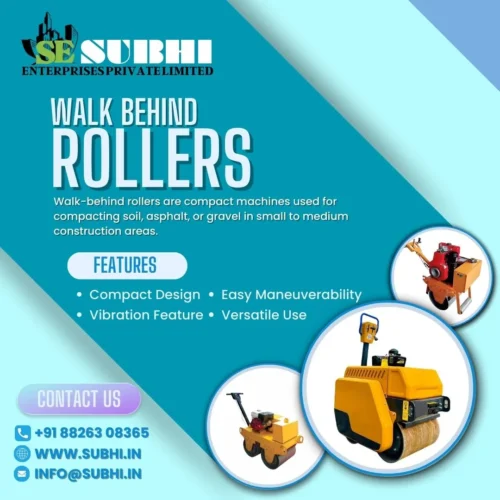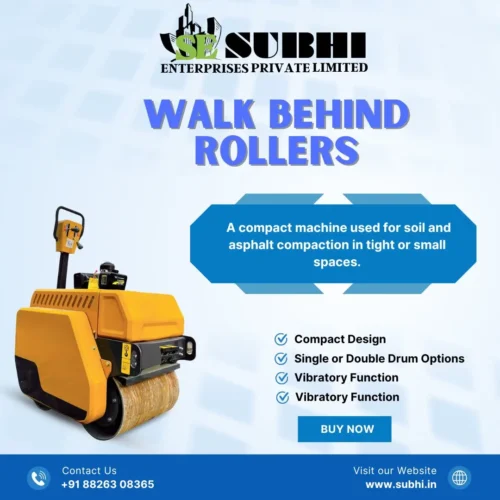Walk behind Rollers
Everything in construction or road works can be completed with the assistance of enormous equipment, it is no surprise. The whirring bulldozers, massive excavators, and towering cranes are shown all the attention, but the equipment that is often neglected at the back is known as the walk-behind rollers, which works compactly and quietly like a hero.
Make no mistake, the walk-behind rollers does not look like it has much to offer at first glance. However, it does tend to assist in landscaping, road-patching, driveway repairs, and many more. The next time you decide to visit a construction site, you can spot a small wheeled machine guiding and being maneuvered like a lawn mower which can be identified as a walk-behind rollers.
In this piece we will look what walk-behind rollers are along with their importance and discuss where exactly do they fit in the construction and compaction industry.
Features of A Walk-Behind Roller
A walk-behind rollers, also known as a pedestrian roller or hand-guided roller, is a compacting machine that is designed to be manually operated and is moved forward by a person walking behind it. Unlike ride-on rollers (which appear similar to miniature steamrollers), these machines are guided with handlebars and control panels like those found on a powered lawnmower or snowblower.
These rollers may either use one or two steel drums (cylindrical rollers) that compress soil, gravel, asphalt, or other material. They may also be smooth or fitted with mechanisms that vibrate to aid in compaction.
In summary, a walk-behind rollers is a compact, versatile, and powerful machine best suited for small- to mid-sized compaction jobs. Precision and mobility may be more important, which is where it excels, even though it cannot dethrone giant ride-on rollers for highway projects.

Compaction Equipment Development Through Time
Walk-Behind Rollers, the idea of ground compaction has existed, and is thought to have originated from Ancient builders who recognized a strong, well-compacted foundation soil serves, be it for a hut or a temple.
It wasn’t until the 19th century with the introduction of steam powered road rollers in Europe that modern rollers came into use. The inception of modern roller history dates to the time of the first steam powered rollers, and further advances in fuel engines, hydraulics, and construction materials have led to the modern rollers we have today.
One could argue that compacting areas inaccessible to large machinery is one of the contemporary challenges needing solution. walk behind rollers during maintenance and construction operatons.
Why Use a Walk-Behind Roller?
1. Compactness and Mobility
Walk-behind rollers surely have an edge in terms of mobility and compactness when compared to other types of rollers. In addition to being compact vertically, these machines can access previously inaccessible places such as pedestrian sidewalks, crosswalks, trenches, and driveways. This makes them perfect for construction zones or other sites with restricted space.
2. Cost Efficiency
Small contractors, landscapers, and budget constrained municipalities are the ones who reap the most benefits from walk-behind rollers, which serve approximately the same purpose as ride-on rollers but come at a much lower purchase, maintenance, and operational cost.
3. Ease of Use
It does not take long to learn how to handle the tool. Familiarity with the controls is handy, but most walk-behind rollers are designed for easy maneuvering. Furthermore, the reduced operating speed makes them safer to use since there is less risk involved, and everything is visible.
4. Versatility
The walk-behind rollers can work on multiple surfaces: soil, sand, asphalt, or gravel. Some of their uses are:

Construction of side walks or pathways
(i) Repairs on driveways.
(ii) Patch up potholes.
(iii) Gardening and landscaping
(iv) Compacting base materials before paving or tiling
Types of Walk-Behind Rollers
Not all walk-behind rollers are created equal. Different rollers work better with different jobs and materials, and all depend on the size of the area being compacted. The different types include the following:
(1.) Single Drum Rollers
The Walk-Behind Rollers are constructed with a single drum at the front, while the back consists of wheels or tracks. Single drum rollers work well in edges and more confined spaces. They offer optimal turning radius while still maintaining flexibility due to the single drum.
(2.) Double Drum Rollers
These are also known as tandem rollers and they have two steel drums, one in the front and the other in the rear. This type has better compaction performance because both drums assist in flattening the surface. They are frequently employed on asphalt or larger areas where additional weight and power are required.
(3.) Vibratory Rollers
Single and double drum rollers have the option of rotating wider or vibrating drums. The vibrations assist in settling particles in a more rapid and dense manner as opposed to applying static pressure alone. Those rollers are particularly efficient on granular materials such as gravel or sand.
Characteristics To Search For Walk–Behind Rollers
Walk-Behind Rollers: If you are planning on purchasing or renting a walk-behind roller, here are important features to take into consideration.
1. Operating Weight
In compaction way, weight is a crucial factor. A more powerful unit results in deeper and more through compaction due to construction. On the other side, there needs to be some form of compromise when it comes to ease of transport and maneuverability.
2. Drum Width
In comparison to drums with a smaller width, wider drums helps for greater distance to be covered in a shorter time. For restricted areas or smaller areas, a narrower drum of around 20-30 inches is ideal. To minimize the number of passes to increase surface area, wider drums with 40+ inch widths are more suitable.
3. Amplitude and Frequency of Vibration
For fine grained materials, procured and adjustable vibration settings is a must. Such a level of control makes it easier to control the degree and intensity of compaction.
4. Water Sprinkle System
This feature is particularly important to the operation of the roller with hot asphalt. Water reduces the chances of the rollers sticking to the asphalt surface.
5. Ease of Maintenance
Choose machines with filters that can be easily replaced, accessible engine parts, and adequate supply of replacement components. A roller that is difficult to service will not remain on site for long.
How to Operate a Walk Behind Roller
Operating a walk–behind rollers does not require advanced skills, but one should be attentive and careful. Here is a rough guide on how to operate it.
1. Pre–Check the Machine:
Ensure fuel and oil levels are adequate, inspect the drums and check if controls function properly; everything should be within satisfactory limits.
2. Start the Engine:
Allow the engine to warm for a couple of minutes after starting it up using the provided pull cord or electric starter.
3. Engage the Vibratory System (if needed):
Use vibrations only when compacting appropriate materials and do not use it on soft or unstable ground.
4. Guide the Machine:
Walk at a steady pace while guiding the roller with both hands. Be sure to overlap each pass slightly for complete and even coverage.
5. Monitor Progress:
After a few passes, take a look at the compactive effort. A firm surface without dips or bumps will indicate that the desired quality is achieved.
6. Shut Down Safely:
Vibration must be turned off; the throttle should be reduced and the engine shut down. If asphalt or other sticky materials were being used, the equipment must be cleaned.
Walk–Behind Rollers Common Mistakes to Avoid
Walk-Behind Rollers: The lack of complexity with walk-behind rollers does not mitigate the possibility of mistakes that can severely undermine your compaction efforts:
(i) Over-compacting : While the number of passes are being increased, soil will also become more dense and in dry conditions, crack.
(ii) Incorrect use of vibration : Know your material. Vibrating clay or wet soil will make things worse, not better.
(iii) Neglecting maintenance : Walk behind rollers require regular maintenance just like any other piece of equipment.
(iv) Uneven compaction : Leaving gaps between where passes are made, or changing the distance between passes leads to inconsistent surfaces, particularly in asphalt pavements
Maintenance Tips For walk–behind rollers
Just like any other piece of machinery, a walk-behind rollers requires its fair share of maintenance. Here are a few pointers that will keep it operating in good condition:
(i) Inspect all fluids (oil, fuel, hydraulic fluid) daily
(ii) Check belts, hoses, and drums for function prior to every usage
(iii) Remove mud or asphalt accumulation after completing tasks to avoid buildup
(iv) Keep in a dry indoor space when not being utilized in order to reduce rust and weather damage
(v) Follow the maintenance schedule provided by the make for servicing and parts replacements.
The Bottom Line
Walk behind rollers may not seem like the most interesting equipment at a construction site, however, their compact size does make them particularly useful. These tools are a must carry for anyone who needs to do reliable, compact, and effective work in constricted spaces.
If you’re a contracted professional or a novice dealing with your first landscaping project, a walk-behind rollers will work far better than an average roller, guaranteeing not only safe, but also smooth work done in a professional manner.
From being an ultra compact tool to complete a task in little time, its size will prove that good things indeed come in small packages. In an era where the right tool makes all the difference, the walk behind rollers are a perfect example.
How about a walk-behind rollers for rent or purchase? Take time to shop around for different models, ask the right questions, and make sure to purchase one that suits your job requirements. Your back will be grateful, and so will your future endeavors.
